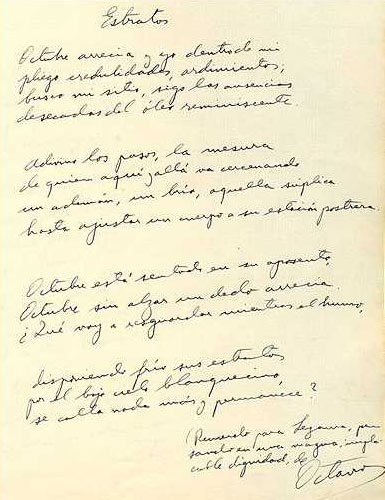4.1.2.8.1 Poetic pieces published by Octavio Smith (1921 – 1987) in “Orígenes”

Although most of Octavio Smith’s lyrical production prior to the Revolution was collected in his poetry collection “Del furtivo destierro”, some other pieces appeared in the magazine “Orígenes” after 1947, the date of the aforementioned poetry collection, which exhibit certain peculiarities, without breaking with the essential characteristics of Smith’s poetics.
In 1949 he published a series of poems in the magazine, the first of them entitled “Wife’s Zone” – apparently not the common title of the series – and the others under the titles of “Prince Heard in the Afternoon”, “Walk of the Wide Summer”, “Through the Chat, I Confess…”, “White and Mortal Intact”, “The Slow Fury”, “Savanna”, “Juniper Round”, “Girl from the Mauve House” and “From Cervantes Park”
In several of his pieces, the iteration of four-line stanzas is evident, a way of providing poetic order to the author’s universe of impressions. However, he always deploys free verse of soaring lyrical scope, in which the inveterate cult of the creator is omnipresent, from a pantheistic worldview.
The theme of women, as a fine evocation of spirit and sublime flesh, is also present in these collections of poems, not only from the sacred wife but gravitating in verses of evasive sensuality, as in the first stanzas of the poem “Blanca y mortal intacta”, composed of six stanzas of four lines:
“Your flesh with the moon in play declaimed
like the icy sistrum of the inviolate smooth.
What oracle of the scattered marble of the boats
you release, held back on the steps of the temple?
The melodious hollow is filled with night
from your body. But nothing from you spreads
but the song held as an enveloping mirror
whose brilliance disturbs, diffuses and does not dissolve. (…)”
In 1953, he also published the poem “Of Interiors,” apparently a collection of poems with that title he had planned. In it, the topic of death is present, a crossing of memory chambers that interweave evocation, in Smith’s customary lyricism, of tight free verse that conveys the preeminence of the goal of poeticizing reality over uncovered nostalgia.
In 1954, he published “Azar de diálogos,” conceived as a dramatic poem, in which the characters, including the personified afternoon, convey their impressions. Widowhood, orphanhood, and the emptiness of the furniture all refer to the context of family loss and, in general, the eternal nature of absence. This was the last poem Smith published in Orígenes, the culmination of a lyrical career that bore precious fruit, although it was not particularly prolific.








